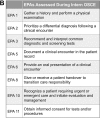Assessing Entrustable Professional Activities Using an Orientation OSCE: Identifying the Gaps
- PMID: 31024656
- PMCID: PMC6476083
- DOI: 10.4300/JGME-D-18-00601.2
Assessing Entrustable Professional Activities Using an Orientation OSCE: Identifying the Gaps
Abstract
Background: A residency program's intern cohort is comprised of individuals from different medical schools that place varying levels of emphasis on Core Entrustable Professional Activities for Entering Residency (CEPAERs). Program directors have expressed concerns about the preparedness of medical school graduates. Though guiding principles for implementation of the CEPAERs have been published, studies using this framework to assess interns' baseline skills during orientation are limited.
Objective: A CEPAER-based objective structured clinical examination (OSCE) was implemented with the aims to (1) assess each intern's baseline clinical skills and provide formative feedback; (2) determine an intern's readiness for resident responsibilities; (3) inform individualized education plans; and (4) address identified gaps through curricular change.
Methods: During orientation, all 33 interns from internal medicine (categorical, preliminary, and medicine-psychiatry) participated in the OSCE. Six 20-minute stations evaluated 8 EPAs. Faculty completed a global assessment, and standardized patients completed a communications checklist and global assessment. All interns completed a self-assessment of baseline skills and a post-OSCE survey.
Results: Stations assessing handoffs, informed consent, and subjective, objective, assessment, and plan (SOAP) note were the lowest-performing stations. Interns performed lower in skills for which they did not report previous training. Formal instruction was incorporated into didactic sessions for the lowest-performing stations. The majority of interns indicated that the assessment was useful, and immediate feedback was beneficial.
Conclusions: This OSCE during orientation offers just-in-time baseline information regarding interns' critical skills and may lead to individualized feedback as well as continuous curricular improvement.
Conflict of interest statement
Conflict of interest: The authors declare they have no competing interests.
Figures






References
-
- Brown DR, Warren JB, Hyderi A, Drusin RE, Moeller J, Rosenfeld M, et al. Finding a path to entrustment in undergraduate medical education: a progress report from the AAMC Core Entrustable Professional Activities for Entering Residency Entrustment Concept Group. Acad Med. 2017;92(6):774–779. doi: 10.1097/ACM.0000000000001544. - DOI - PubMed
-
- Lomis K, Amiel JM, Ryan MS, Esposito K, Green M, Stagnaro-Green A, et al. Implementing an entrustable professional activities framework in undergraduate medical education: early lessons from the AAMC Core Entrustable Professional Activities for Entering Residency pilot. Acad Med. 2017;92(6):765–770. doi: 10.1097/ACM.0000000000001543. - DOI - PubMed
-
- Lypson ML, Frohna JG, Gruppen LD, Woolliscroft JO. Assessing residents' competencies at baseline: identifying the gaps. Acad Med. 2004;79(6):564–570. - PubMed
MeSH terms
LinkOut - more resources
Full Text Sources
